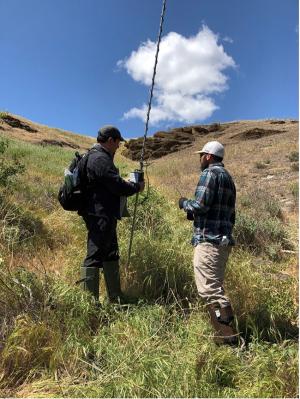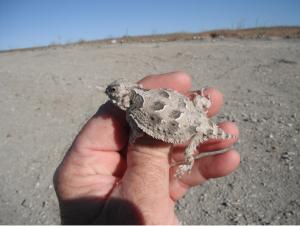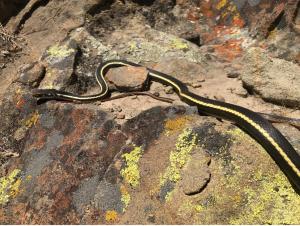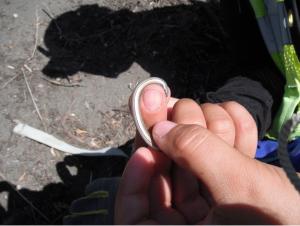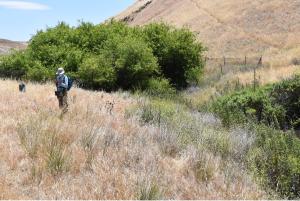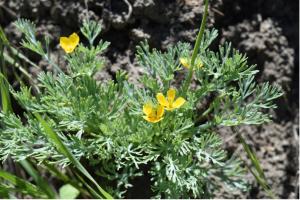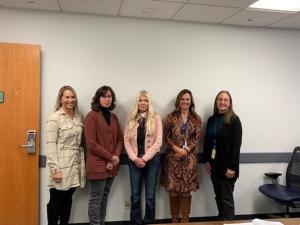Cross-directorate team works to survey the Lab’s biodiversity
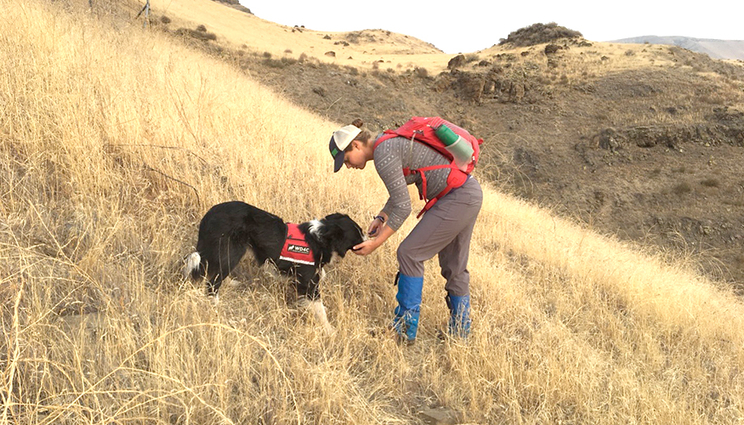 (Download Image)
(Download Image)
LLNL partnered with Working Dogs for Conservation to conduct San Joaquin kit fox surveys at Site 300. Many of them rescued, scat detection dogs are trained to detect the scent of certain hard-to-track animals, like the San Joaquin kit fox, to see if they have been on site. Photo by Lisa Paterson/LLNL.
From the rolling hills of Tracy to the grassy plains of Livermore, LLNL’s lands are replete with biodiversity, and keeping track of the resident flora and fauna is no small feat.
Acoustic monitoring was used to passively search for rare bat species. Wildlife biologists from ECORP Consulting are shown installing a Wildlife Acoustics SM4BAT-FS unit using the SMM-U2 microphone in a remote canyon at Site 300. Photo by Lisa Paterson/LLNL.
Located at the intersection of Coastal and Central Valley environments, the Livermore Valley and surrounding hills attracted early botanists and wildlife biologists from UC Berkeley and the California Academy of Sciences studying biodiversity in the state.
Within and around Site 300’s 7,000 acres of rural foothills, there are five species and three critical habitats protected by the Federal Endangered Species Act, two protected by the California Endangered Species Act and more than 30 species considered rare by the state of California. Among those that call the area home are the endangered flowering plant the large-flowered fiddleneck, the Alameda whipsnake, the California tiger salamander, the California red-legged frog and birds such as the tricolored blackbird and the Swainson’s hawk.
ECORP, an environmental consulting firm contracted to survey wildlife at Site 300, used an array of remote infrared cameras to detect animals like bobcats (L) and American badgers (R). Photo by Phil Wasz/ECORP.
Because of the diversity of special status plants, animals and habitats that occur at LLNL sites, an analysis of potential impacts to protected species and habitats is an important part of the Lab’s latest Sitewide Environmental Impact Statement (SWEIS).
To tackle this monumental task, a cross-Lab team with members from ES&H, Supply Chain Management (SCM) and the Office of the Chief Financial Officer (OCFO) came together from 2018 to 2022 to manage subcontracts with expert wildlife biologists and botanists, who would complete the required habitat, rare plant and wildlife surveys.
“This project took a lot of collaboration between our organizations, and we had a really great team,” said Kelly Trabert, group manager for SCM’s Commercial Goods and Services team.
Site 300 is home to many rare reptiles, like this Blainville’s horned lizard. Photo by Eric Stitt/ECORP.
As Lab staff and subcontractors worked to prepare the draft SWEIS, last-minute changes meant that the business side of the required wildlife surveys needed to be managed in-house instead of by an external firm. Pulling together expertise from across the Lab, LLNL ecologist Lisa Paterson (ES&H) and LLNL wildlife biologist Caleb Murphy (ES&H) partnered with Trabert (SCM), contract analyst DeeAnna Hill (SCM) and resource analyst Laura O’Brien (OCFO).
“We needed their expertise to make sure contracting was completed according to Lab policies and procedures and the project stayed on schedule,” Paterson said of the contracting team. “We really relied on their support.”
The five-member group worked with innovative environmental consulting firms including ECORP, Working Dogs for Conservation, Nomad Ecology, Sequoia Ecological Consulting and Kleinfelder to conduct surveys for special status plants, animals and habitats that occur at LLNL sites.
One rare reptile observed during SWEIS surveys is the Alameda whipsnake, which is protected as a threatened species under both the Federal and California Endangered Species Acts. Photo by Caleb Murphy/LLNL.
Environmental consultants surveyed the LLNL Remote Test Site (Site 300), the Livermore Site and the area surrounding the Arroyo Mocho Pumping Station, which provides drinking water to LLNL’s Livermore Site. Their results provided background information for the analysis of potential impacts to protected species and habitats completed as part of the SWEIS.
The surveys used both high- and low-tech methods.
ECORP Consulting Inc. used acoustic monitoring to passively search for rare bat species at Site 300, deploying Wildlife Acoustics SM4BAT-FS units with SMM-U2 microphones in multiple locations to record bat acoustics as full-spectrum WAV files. They then used specialized software to analyze the WAV files and determine which bat species were present. The 14 species of bats recorded at Site 300 during these surveys include four rare species: the pallid bat, the western red bat, Townsend’s big-eared bat and the western mastiff bat.
The rare Northern California legless lizard was a target species for reptile surveys. Although this species resembles snakes because it lacks legs and external ear openings, legless lizards are decidedly lizards as evidenced by the presence of eyelids. This species prefers to hide in shallow sandy soil and is notoriously difficult to detect. Several low-tech methods were used to find legless lizards and other rare reptiles. Survey methods included driving surveys, walking transects through quadrants that were randomly placed throughout suitable habitat, coverboard surveys and carefully raking in suitable habitat. Photo by Eric Stitt/ECORP.
The ECORP team also used an extensive array of remote infrared cameras to find large- and mid-sized carnivores at Site 300, baiting each camera with a predator attractant and a can of cat food. Two species considered rare in this area, the American badger and the mountain lion, were targets of the camera surveys. Although images of several American badgers were captured, no mountain lions were observed during the SWEIS surveys. Mountain lions have previously been observed at Site 300, but this species has very large home ranges and can be very elusive in its natural habitat.
Technology aside, the darlings of the biological survey team were the canines of Working Dogs for Conservation. Many of them rescues, scat detection dogs can find the scent of many hard-to-track animals like the San Joaquin kit fox to see if they have been on site. Although Site 300 is within the northern range of the San Joaquin kit fox, this species has not been observed at or near Site 300 for several decades. Surveys conducted with scent detection dogs helped to confirm that San Joaquin kit fox do not occur at Site 300.
LLNL Ecologist Lisa Paterson is shown assisting with surveys for protected habitats, like the riparian wetlands shown in this photograph. This riparian habitat also is habitat for protected amphibians like the California red-legged frog and one rare invertebrate, the valley longhorn elderberry beetle. Photo by Erin McDermott/Nomad Ecology.
As if existing challenges weren’t enough, the COVID-19 pandemic and historically bad air quality resulting from wildfires threatened to impact the survey schedules. But because the work was conducted outside and was essential to the completion of the SWEIS, surveys were allowed to continue during the shutdown.
Kudos from Lab leaders
In a massive collective effort, the team completed the surveys underbudget and on time for the Nov. 4, 2022, release of the draft SWEIS for public review.
“We thank Paterson and her team of experts for providing outstanding support to the SWEIS by providing the results of the surveys and conducting reviews of biological impacts analyses sections," said the LLNL SWEIS Project Manager Hank Khan.
The California diamond-petaled poppy is an extremely rare species found in remote locations at LLNL’s Site 300. This species was thought to be extinct for 50 years when it was rediscovered at Site 300 in 1997. Current SWEIS surveys confirmed this species is still present in four remote locations at Site 300. This tiny plant has leaves and fruits that resemble its common relative the California poppy, but it has yellow flowers and only reaches 5-30 cm in height. Photo by Lisa Paterson/LLNL.
But the group’s efforts didn’t stop there. In a move rarely seen, the hyper-efficient team returned the balance of their funding to DOE. This caught the attention of O&B Principal Associate Director Cynthia Rivera, who presented them with an award of recognition in November.
O&B Principal Associate Director Cynthia Rivera presented the SWEIS biological survey team, which included members from ES&H, OCFO and Supply Chain Management, with an award of recognition in November 2022. From left to right: Laura O’Brien (OCFO), Lisa Paterson (ES&H), DeeAnna Hill (SCM), Kelly Trabert (SCM) and Cynthia Rivera (O&B). Not shown: Caleb Murphy. Photo by Courtney Cook/LLNL.Trabert and Hill were pleased that the project was able to tap into local small businesses to conduct the surveys, including many that are women-owned. They noted that this practice brings the Lab closer to reaching socio-economic goals while providing great services.
The interdisciplinary group was in constant communication and worked well together, exemplifying successful cross-team collaboration, which is one of O&B’s strategic goals.
“[The SWEIS biological survey team] hit the ground running and really helped us to get this thing done,” Murphy said. “This prevented us from having to delay the SWEIS.”
--Kimberly Moore
Contact
 Anne M. Stark
Anne M. Stark
[email protected]
(925) 422-9799
Tags
Physical and Life SciencesFeatured Articles




